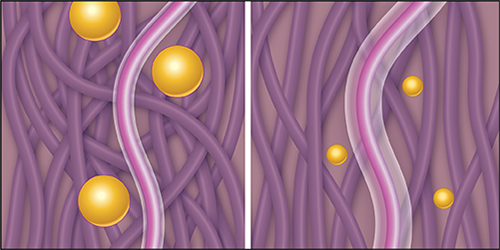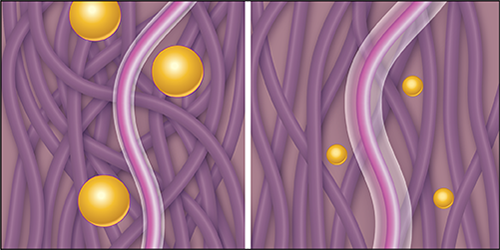Small Particles Untangle Polymer Chains
Molten polymer can be likened to an entangled nest of extremely long slithering snakes. How easily individual polymer chains slide past one another depends primarily on the chain length—long polymers get more entangled than short ones and so have a lower mobility. But as researchers have long known, adding nanoparticles to the polymer can also affect chain mobility because the particles tend to trap the chains and hinder their motion. Now, a counterexample to this rule has been explained by Erkan Senses, from the National Institute of Standards and Technology, Maryland, and the University of Maryland in College Park, and colleagues. Their experiments show that interspersing particles smaller than the openings within the nest promotes chain mobility and disentangles the polymer.
The team compared a pure polymer to two polymer-nanoparticle mixtures, one containing 3 nm gold particles and the other containing 20 nm particles—particle sizes that were chosen to be smaller and larger than the space between tangles, respectively. Using various spectroscopic and rheological techniques, the group probed the dynamics of individual chains and the bulk mixtures.
As expected, the polymer-nanoparticle mixtures containing the larger particles had a higher viscosity than the pure polymer. In contrast, mixtures containing the smaller particles had a lower viscosity. From observing individual chains in the latter mixture, the researchers concluded that the small nanoparticles make the chains appear fatter to their neighbors, pushing them apart and giving them more wiggle room in which to unravel. The findings suggest that the addition of appropriately sized nanoparticles to a polymer could be used control its viscosity, an important parameter for industrial processes like extrusion.
This research is published in Physical Review Letters.
–Katherine Wright
Katherine Wright is a Contributing Editor for Physics.





